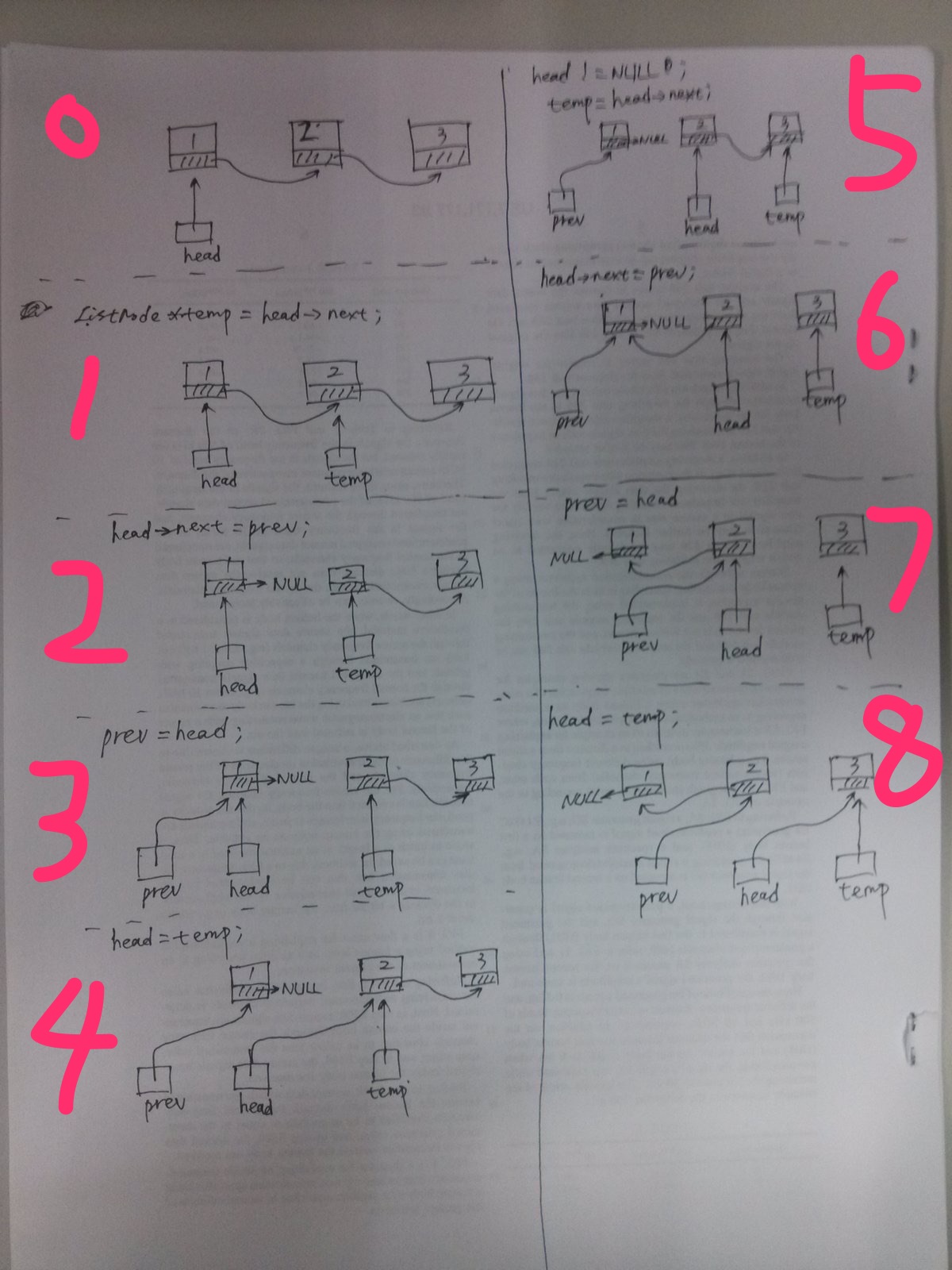Reverse Linked List
Question
- leetcode: (206) Reverse Linked List | LeetCode OJ
- lintcode: (35) Reverse Linked List
Reverse a linked list.
Example
For linked list 1->2->3, the reversed linked list is 3->2->1
Challenge
Reverse it in-place and in one-pass
Solution1 - Non-recursively
It would be much easier to reverse an array than a linked list, since array supports random access with index, while singly linked list can ONLY be operated through its head node. So an approach without index is required.
Think about how '1->2->3' can become '3->2->1'. Starting from '1', we should turn '1->2' into '2->1', then '2->3' into '3->2', and so on. The key is how to swap two adjacent nodes.
temp = head -> next;
head->next = prev;
prev = head;
head = temp;
The above code maintains two pointer, prev and head, and keeps record of next node before swapping. More detailed analysis:

- Keep record of next node
- change
head->nexttoprev - update
prevwithhead, to keep moving forward - update
headwith the record in step 1, for the sake of next loop
Python
# Definition for singly-linked list.
# class ListNode:
# def __init__(self, x):
# self.val = x
# self.next = None
class Solution:
# @param {ListNode} head
# @return {ListNode}
def reverseList(self, head):
prev = None
curr = head
while curr is not None:
temp = curr.next
curr.next = prev
prev = curr
curr = temp
# fix head
head = prev
return head
C++
/**
* Definition for singly-linked list.
* struct ListNode {
* int val;
* ListNode *next;
* ListNode(int x) : val(x), next(NULL) {}
* };
*/
class Solution {
public:
ListNode* reverse(ListNode* head) {
ListNode *prev = NULL;
ListNode *curr = head;
while (curr != NULL) {
ListNode *temp = curr->next;
curr->next = prev;
prev = curr;
curr = temp;
}
// fix head
head = prev;
return head;
}
};
Java
/**
* Definition for singly-linked list.
* public class ListNode {
* int val;
* ListNode next;
* ListNode(int x) { val = x; }
* }
*/
public class Solution {
public ListNode reverseList(ListNode head) {
ListNode prev = null;
ListNode curr = head;
while (curr != null) {
ListNode temp = curr.next;
curr.next = prev;
prev = curr;
curr = temp;
}
// fix head
head = prev;
return head;
}
}
Source Code Analysis
Already covered in the solution part. One more word, the assignment of prev is neat and skilled.
Complexity
Traversing the linked list leads to O(n) time complexity, and auxiliary space complexity is O(1).
Solution2 - Recursively
Three cases when the recursion ceases:
- If given linked list is null, just return.
- If given linked list has only one node, return that node.
- If given linked list has at least two nodes, pick out the head node and regard the following nodes as a sub-linked-list, swap them, then recurse that sub-linked-list.
Be careful when swapping the head node (refer as nodeY) and head of the sub-linked-list (refer as nodeX ): First, swap nodeY and nodeX; Second, assign null to nodeY->next (or it would fall into infinite loop, and tail of result list won't point to null).
Python
"""
Definition of ListNode
class ListNode(object):
def __init__(self, val, next=None):
self.val = val
self.next = next
"""
class Solution:
"""
@param head: The first node of the linked list.
@return: You should return the head of the reversed linked list.
Reverse it in-place.
"""
def reverse(self, head):
# case1: empty list
if head is None:
return head
# case2: only one element list
if head.next is None:
return head
# case3: reverse from the rest after head
newHead = self.reverse(head.next)
# reverse between head and head->next
head.next.next = head
# unlink list from the rest
head.next = None
return newHead
C++
/**
* Definition of ListNode
*
* class ListNode {
* public:
* int val;
* ListNode *next;
*
* ListNode(int val) {
* this->val = val;
* this->next = NULL;
* }
* }
*/
class Solution {
public:
/**
* @param head: The first node of linked list.
* @return: The new head of reversed linked list.
*/
ListNode *reverse(ListNode *head) {
// case1: empty list
if (head == NULL) return head;
// case2: only one element list
if (head->next == NULL) return head;
// case3: reverse from the rest after head
ListNode *newHead = reverse(head->next);
// reverse between head and head->next
head->next->next = head;
// unlink list from the rest
head->next = NULL;
return newHead;
}
};
Java
/**
* Definition for singly-linked list.
* public class ListNode {
* int val;
* ListNode next;
* ListNode(int x) { val = x; }
* }
*/
public class Solution {
public ListNode reverse(ListNode head) {
// case1: empty list
if (head == null) return head;
// case2: only one element list
if (head.next == null) return head;
// case3: reverse from the rest after head
ListNode newHead = reverse(head.next);
// reverse between head and head->next
head.next.next = head;
// unlink list from the rest
head.next = null;
return newHead;
}
}
Source Code Analysis
case1 and case2 can be combined.What case3 returns is head of reversed list, which means it is exact the same Node (tail of origin linked list) through the recursion.
Complexity
The depth of recursion: O(n). Time Complexity: O(N). Space Complexity (without considering the recursion stack): O(1).
